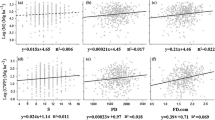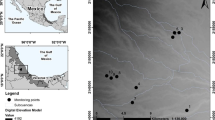Abstract
Plant diversity is multidimensional and scale-dependent. In this chapter, patterns of taxonomic, functional, and phylogenetic diversity in the tropical cloud forests (TCFs) in Hainan were studied. A total of 48 plots (20 m × 20 m) were established in the TCFs in Jianfengling (JFL, n = 12), Bawangling (BWL, n = 21), and Limushan (LMS, n = 15). Within each plot, plants with diameter at breast height (DBH) ≥1 cm were identified, and their height and DBH were measured; plants’ leaves and branches were sampled for measuring wood density, leaf thickness, specific leaf area, and chlorophyll content. The α and β diversity was measured using these data and compared among TCFs at 5 m × 5 m, 10 m × 10 m, and 20 m × 20 m scales. Our results showed that, at each scale, the stem abundance and species richness of TCFs decreased from JFL to BWL and then to LMS, and the Jaccard index and Bray-Curtis index of the TCF in BWL was lower than that in LMS and JFL. The TCF in JFL showed lower functional richness and Rao’s quadratic entropy but higher functional evenness than the others, while its functional β diversity was also lower. The TCF in BWL showed the highest phylogenetic diversity (PD) and mean nearest phylogenetic distance (MNND), that in JFL showed the highest mean pairwise phylogenetic distance (MPD) but lowest MNND, and that in LMS showed the lowest PD and MPD. The mean pairwise trait distance between communities of TCFs decreased from JFL to BWL and then to LMS; TCF in BWL showed the highest values of mean nearest trait distance at the 5 m × 5 m scale but the lowest values at the 20 m × 20 m scale, while the values in JFL were lower than those in LMS at each scale. These results demonstrate the significant diversity differences across the TCFs in Hainan and suggest that the scale dependence of diversity is sensitive to the way diversity is measured.
Access this chapter
Tax calculation will be finalised at checkout
Purchases are for personal use only
Similar content being viewed by others

References
Blomberg SP, Garland T, Ives AAR (2003) Testing for phylogenetic signal in comparative data: behavioral traits are more labile. Evolution 57(4):717–745
Bray JR, Curtis JT (1957) An ordination of the upland forest communities of southern Wisconsin. Ecol Monogr 27(4):325–349
Bu WS (2013) The relationship between biodiversity and ecosystem functioning in natural tropical forests of Hainan Island, China. PhD dissertation, Chinese Academy of Forestry, Beijing. pp 40–59. (In Chinese)
Bu WS, Zang RG, Ding Y (2014) Field observed relationship between biodiversity and ecosystem functioning during secondary succession in a tropical lowland rainforest. Acta Oecol 55(1):1–7
Butterfield BJ, Cavieres LA, Callaway RM, Cook BJ, Kikvidze Z, Lortie CJ, Zaitchek B (2013) Alpine cushion plants inhibit the loss of phylogenetic diversity in severe environments. Ecol Lett 16(4):478–486
Cadotte MW, Carscadden K, Nicholas M (2011) Beyond species: functional diversity and the maintenance of ecological processes and services. J Appl Ecol 48(5):1079–1087
Cornelissen JHC, Lavorel S, Garnier E, Díaz S, Buchmann N, Gurvich DE, Reich PB, ter Steege H, Morgan HD, van der Heijden MGA, Pausas JG, Poorter H (2003) A handbook of protocols for standardized and easy measurement of plant functional traits worldwide. Aust J Bot 51(4):335–380
Cornwell WK, Schwilk DW, Ackerly DD (2006) A trait-based test for habitat filtering: convex hull volume. Ecology 87(6):1465–1471
Devictor V, Mouillot D, Meynard C, Jiguet F, Thuiller W, Mouquet N (2010) Spatial mismatch and congruence between taxonomic, phylogenetic and functional diversity: the need for integrative conservation strategies in a changing world. Ecol Lett 13(8):1030–1040
Faith DP (1992) Conservation evaluation and phylogenetic diversity. Biol Conserv 61(1):1–10
Fan J (2015) Spatial and temporal pattern of biodiversity and its correlation with aboveground biomass in coniferous and broadleaved mixed forests of Jiaohe, Jilin. PhD dissertation, Beijing Forestry University, Beijing, pp 73–77. (In Chinese)
Feng G, Zhang JL, Pei NC, Rao MD, Mi XC, Ren HB, Ma KP (2012) Comparison of phylobetadiversity indices based on community data from Gutianshan forest plot. Chin Sci Bull 57(6):623–630
Graham CH, Fine PVA (2008) Phylogenetic beta diversity: linking ecological and evolutionary processes across space in time. Ecol Lett 11(12):1265–1277
Helmus MR, Ives AR (2012) Phylogenetic diversity-area curves. Ecology 93(sp8):S31–S43
Jaccard P (1912) The distribution of the flora in the alpine zone. New Phytol 11(2):37–50
Jetz LW (2008) Future battlegrounds for conservation under global change. Proc R Soc B Biol Sci 275(1640):1261–1270
Legendre P, Borcard D, Peres-Neto PR (2005) Analyzing beta diversity: partitioning the spatial variation of community composition data. Ecol Monogr 75(4):435–450
Lohbeck M, Poorter L, Paz H, Pla L, Breugel MV, Martínez-Ramos M et al (2012) Functional diversity changes during tropical forest succession. Perspect Plant Ecol Evolut Systemat 14(2):89–96
Long WX, Zang RG, Ding Y, Yang M, Chen SW (2011) Environmental characteristics of tropical cloud forests in the rainy season in Bawangling National Nature Reserve on Hainan Island, South China. Chin J Plant Ecol 35(2):137–146. (In Chinese with English abstract)
Long WX, Zang RG, Ding Y, Huang YF (2013) Effects of competition and facilitation on species assemblage in two types of tropical cloud forest. PLoS One 8(4):e60252
Ma KP, Liu CR, Liu YM (1995) Biological community diversity measure IIβ diversity measure method. Chin Biodiver 3(1):38–43. (In Chinese)
Mason NWH, de Bello F (2013) Functional diversity: a tool for answering challenging ecological questions. J Veg Sci 24(5):777–780
Mason NWH, Richardson SJ, Peltzer DA, de Bello F, Wardle DA, Allen RB (2012) Changes in coexistence mechanisms along a long-term soil chronosequence revealed by functional trait diversity. J Ecol 100(3):678–689
Mouchet MA, Villéger S, Mason NW, Mouillot D (2010) Functional diversity measures: an overview of their redundancy and their ability to discriminate community assembly rules. Funct Ecol 24(4):867–876
Pereira JAA, Oliveira-Filho AT, Lemos-Filho JP (2007) Environmental heterogeneity and disturbance by humans control much of the tree species diversity of Atlantic montane forest fragments in SE Brazil. Biodivers Conserv 16(6):1761–1784
Qian H, Jin Y (2015) An updated megaphylogeny of plants, a tool for generating plant phylogenies, and an analysis of phylogenetic community structure. J Plant Ecol 9(2):233–239
Rosauer D, Laffan SW, Crisp MD, Donnellan SC, Cook LG (2009) Phylogenetic endemism: a new approach for identifying geographical concentrations of evolutionary history. Mol Ecol 18(19):4061–4072
Schleuter D, Daufresne M, Massol F (2010) A user’s guide to functional diversity indices. Ecol Monogr 80(3):469–484
Spasojevic MJ, Grace JB, Harrison S, Damschen EI (2014) Functional diversity supports the physiological tolerance hypothesis for plant species richness along climatic gradients. J Ecol 102(2):447–455
Swenson NG, Anglada-Cordero P, Barone JA (2011) Deterministic tropical tree community turnover: evidence from patterns of functional beta diversity along an elevational gradient. Proc R Soc B Biol Sci 278(1707):877–884
Swenson NG, Erickson DL, Mi XC, Bourg NA, Forero-Montaña J, Ge XJ, Howe R, Lake JK, Liu XJ, Ma KP, Pei NC, Thompson J, Uriarte M, Wolf A, Wright SJ, Ye WH, Zhang JL, Zimmerman JK, Kress WJ (2012) Phylogenetic and functional alpha and beta diversity in temperate and tropical tree communities. Ecology 93(8):S112–S125
Venail P, Gross K, Oakley TH, Narwani A, Allan E, Flombaum P, Isbell F, Joshi J, Reich PB, Tilman D, Ruijven JV, Cardinale BJ (2015) Species richness, but not phylogenetic diversity, influences community biomass production and temporal stability in a re-examination of 16 grassland biodiversity studies. Funct Ecol 29(5):615–626
Wang XG, Swenson NG, Wiegand T, Wolf A, Lin F, Ye J, Yuan ZQ, Shi S, Bai XJ, Xing DL, Hao ZQ (2008) Spatial variation of species diversity across scales in an old-growth temperate forest of China. Ecol Res 23(4):709–717
Wang XG, Hao ZQ, Ye J, Zhang J, Li BH, Yao XL (2013) Phylogenetic and functional diversity area relationships in two temperate forests. Ecography 36(8):883–893
Webb CO, Ackerly DD, McPeek MA, Donoghue MJ (2002) Phylogenies and community ecology. Annu Rev Ecol Syst 33(1):475–505
Webb CO, Ackerly DD, Kembel SW (2008) Phylocom: software for the analysis of phylogenetic community structure and trait evolution. Bioinformatics 24(18):2098–2100
Weiher E, Keddy PA (1995) Assembly rules, null models, and trait dispersion: new question from old patterns. Oikos 74(1):159–164
Xue QN (2015) Functional diversity research of forest communities in Qiliyu, Shanxi. PhD dissertation, Shanxi Normal University, Shanxi, pp 13–21. (In Chinese)
Yang J, Lu MM, Cao M, Li J, Lin LX (2014) Phylogenetic and functional alpha and beta diversity in mid-mountain humid evergreen broad-leaved forest. Chin Sci Bull 59(24):2349–2358. (In Chinese with English abstract)
Zanne AE, Tank DC, Cornwell WK, Eastman JM, Smith SA, Fitzjohn RG et al (2014) Corrigendum: three keys to the radiation of angiosperms into freezing environments. Nature 514(7522):394–394
Author information
Authors and Affiliations
Corresponding author
Editor information
Editors and Affiliations
Rights and permissions
Copyright information
© 2022 Springer Nature Singapore Pte Ltd.
About this chapter
Cite this chapter
Wang, X., Long, W., Zang, R., Xiong, M. (2022). Variation in Plant Diversity in Three Tropical Cloud Forests in Hainan Island. In: Long, W. (eds) Tropical Cloud Forest Ecology in Hainan Island. Springer, Singapore. https://doi.org/10.1007/978-981-19-3655-5_3
Download citation
DOI: https://doi.org/10.1007/978-981-19-3655-5_3
Published:
Publisher Name: Springer, Singapore
Print ISBN: 978-981-19-3654-8
Online ISBN: 978-981-19-3655-5
eBook Packages: Biomedical and Life SciencesBiomedical and Life Sciences (R0)



